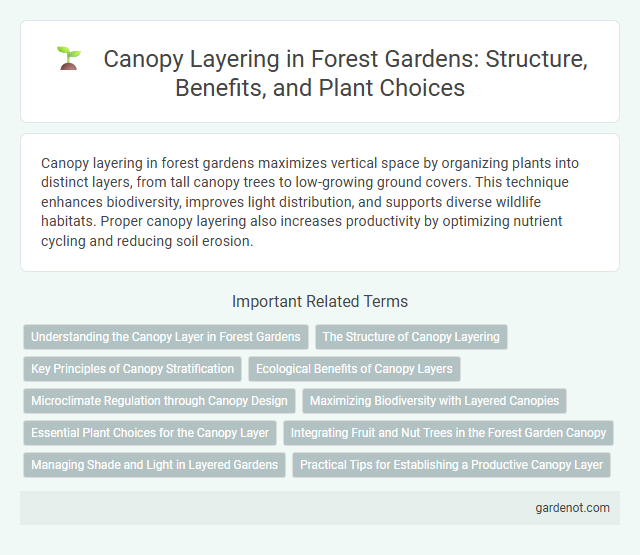Canopy layering in forest gardens maximizes vertical space by organizing plants into distinct layers, from tall canopy trees to low-growing ground covers. This technique enhances biodiversity, improves light distribution, and supports diverse wildlife habitats. Proper canopy layering also increases productivity by optimizing nutrient cycling and reducing soil erosion.
Understanding the Canopy Layer in Forest Gardens
Canopy layering in forest gardens involves arranging plants in multiple vertical strata to mimic natural forest ecosystems, maximizing space and resource use. The canopy layer, formed by tall trees like fruit or nut species, plays a critical role in providing shade, reducing wind, and sustaining biodiversity. Understanding the canopy layer helps optimize light distribution and supports the growth of understory plants, enhancing overall ecosystem productivity.
The Structure of Canopy Layering
Canopy layering in forest gardens consists of multiple vertical strata including the emergent layer, tall trees, understory trees, shrubs, herbaceous plants, ground covers, and root crops, creating a diverse and productive ecosystem. The structure maximizes sunlight capture, space utilization, and biodiversity by mimicking natural forest stratification. Effective canopy layering enhances microclimate regulation, improves soil health, and supports a variety of wildlife within the garden.
Key Principles of Canopy Stratification
Canopy layering in forest gardens involves organizing plants into distinct vertical layers, maximizing sunlight capture and space efficiency. Key principles of canopy stratification include selecting species with varying heights, root depths, and growth habits to create complementary niches. This vertical diversity enhances biodiversity, improves microclimate regulation, and supports sustainable ecosystem productivity.
Ecological Benefits of Canopy Layers
Canopy layering in forest gardens enhances biodiversity by creating multiple habitats for diverse species, including birds, insects, and understory plants. This stratification improves microclimate regulation, aiding in temperature moderation and moisture retention which supports overall ecosystem resilience. Enhanced nutrient cycling occurs as leaf litter from different canopy layers decomposes at varying rates, enriching soil fertility and promoting sustainable plant growth.
Microclimate Regulation through Canopy Design
Canopy layering in forest gardens creates diverse vertical structures that regulate microclimates by moderating temperature, humidity, and wind exposure. This stratification optimizes sunlight distribution, supporting understorey plant growth and enhancing biodiversity. Effective canopy design reduces evapotranspiration and soil erosion, promoting resilient and sustainable ecosystems.
Maximizing Biodiversity with Layered Canopies
Layered canopies in forest gardens create diverse vertical habitats that support a wide range of plant and animal species, enhancing overall biodiversity. By incorporating multiple layers--from tall canopy trees to understory shrubs and ground cover plants--these systems mimic natural forest structures, promoting ecological balance and resilience. Maximizing biodiversity with layered canopies also improves nutrient cycling, microclimate regulation, and pest control, contributing to a sustainable and productive garden ecosystem.
Essential Plant Choices for the Canopy Layer
The canopy layer in a forest garden primarily includes tall fruit and nut trees such as apple (Malus domestica), pear (Pyrus communis), and chestnut (Castanea spp.), which provide essential shade and microclimate regulation. Selecting drought-tolerant species like oak (Quercus spp.) or nitrogen-fixing trees such as black locust (Robinia pseudoacacia) enhances soil fertility and ecosystem resilience. Incorporating diverse species with varying fruiting times promotes year-round harvest and supports biodiversity within the canopy layer.
Integrating Fruit and Nut Trees in the Forest Garden Canopy
Integrating fruit and nut trees in the forest garden canopy enhances biodiversity and maximizes space by creating multiple vertical layers that mimic natural forest ecosystems. These trees provide essential shade, improve microclimates, and contribute to nutrient cycling, supporting understory plants and groundcover species. Selecting species such as chestnuts, walnuts, and apple trees promotes a resilient and productive canopy, fostering sustainable food production within the forest garden.
Managing Shade and Light in Layered Gardens
Canopy layering in forest gardens strategically manages shade and light by planting tall trees that create a protective upper layer, allowing sunlight to filter through for understory plants. This method optimizes photosynthesis by balancing sunlight exposure, supporting diverse plant species adapted to varying light conditions. Effective canopy management enhances growth, improves microclimates, and increases overall garden productivity.
Practical Tips for Establishing a Productive Canopy Layer
Select fast-growing, sun-loving trees such as fruit or nut species to form a productive canopy layer that maximizes sunlight capture for the overall forest garden. Space trees adequately, typically 10 to 15 feet apart, to allow for healthy crown expansion and air circulation, reducing disease risk and promoting vigorous growth. Regularly prune canopy trees to maintain optimal height and shape, encouraging fruit production and enabling light penetration to lower layers for improved ecosystem productivity.
Canopy layering Infographic

 gardenot.com
gardenot.com